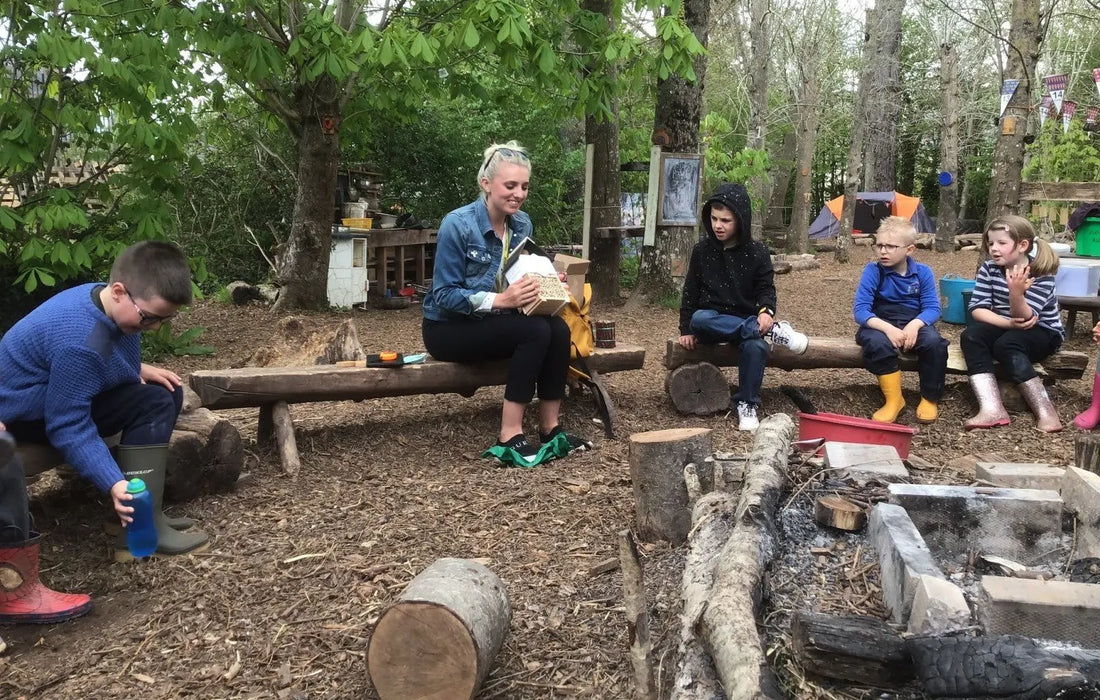Educating our future generation about the bees.
In May I had the pleasure of visiting St Martin's C of E Primary & Nursery School to talk to the Reception, Year 2 and Year 5 children about the importance of bees and how we can help to provide sufficient flowers and homes for them.
The children were so eager to learn, take part and not afraid to ask questions!
I was buzzing to receive the news that bees had moved into their bee hotel which prompted me to share my experience, a few fun facts and the wonderful things the children have been up to.

Can you spot the mason bees?

Learning about bees in the green house
At the beginning of the session the children told me about their school allotment project, where the children had up-cycled pallets turning them into raised beds. Each year group had their own area to grow whatever they wanted - the most popular ingredients were so they could have pizza in the forest! We talked about the process of pollination and how bees are responsible for pollinating 1/3rd of the nutritious food we eat.
Hands up who loves pizza 🙌
No bees = fewer tomatoes. Research has shown that surrounding tomato fields with flowering plants improves yield. Tomatoes are both wind- and bee-pollinated, but bee-pollinated tomatoes have been found to have higher levels of vitamin C and to weigh more. Honeybees cannot pollinate tomatoes because they require a special type of pollination called 'buzz pollination' that honeybees cannot do. Buzz pollinators grab hold of the stem and vibrate their bodies to shake the pollen!
Here is a list of just some of the foods bees pollinate:
Fruit: Almonds, Apples, Apricots, Avocados, Blueberries, Cherries, Cranberries, Grapes, Kiwi, Nectarines, Olives, Peaches & Pears.
Vegetables: Asparagus, Broccoli, Carrots, Cauliflower, Celery, Cucumbers, Honeydew melon, Onions, Pumpkins, Squash, Watermelons
Field: Cotton lint & seed, Legume seed, Peanuts, Rapeseed, Soybeans, Sugar beets, Sunflowers
 /p>
/p>
Together we discussed the 3 different types of bees in the UK: The honeybee, 24 species of bumblebee and over 200 species of solitary bees, identifying them using photos.
We all stood up and buzzed around the classroom, performing the 'waggle dance' which is how honey bees communicate with each other.
The children made their own bee hotels from foraged materials and learnt that these are for solitary bees, which unlike bumblebees and honey bees do not live in hives or colonies. Using our checklist I demonstrated how to successfully install and maintain our bee hotels so they remain safe and healthy for the bees (and the exciting part!) how to know when guests 'check in' to the bee hotel, returning to the bamboo tubes with pollen for food and materials such as mud and leaves to block up the entrance.

Children helping a bee with nearby flowers

Handmade seed balls

Bee-friendly area where seeds are planted
Following my school visit we received some really positive feedback with photos.
“Ironically, a couple of the children found a bee the next week after you came and were able to rescue it using the techniques that you had told them about.” Angela, Forestry School Teacher
The children also made their own seed balls, planted the wildflower seeds we donated and roped off the area so it can grow wild. How buzzing is that!
Thank you St Martin's C of E for inviting me into your classroom.
Faye, Co-founder of Beevive
[All photos taken with consent and permission to share]


